What can we learn from a classic Tuscan garden?
November 10th, 2009
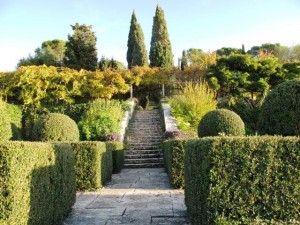
The stone steps of La Foce's terraced garden draw the eye upward, towards two large Italian cypresses
I’ve barely been home from Italy for 24 hours and despite jet lag, I am still alert enough to post my first report about the two week trip to Tuscany.
One of the most memorable days was our tour of La Foce, a Tuscan estate and garden with influences dating to the 15th century when the property was built as an Inn (“Osteria”) by the Hospital of S. Maria della Scala. It is located in the town of Chianciano, about 30 minutes southeast of where we stayed in Montisi.
“Foce” (pronounced Foe-CHAY) means “opening” or “meeting place,” and its origins are traced to the Etruscans. The name refers to the osteria’s location as a stopping place where two prominent roads intersect. The roads were traveled by pilgrims, merchants and travelers who sought rest from their journeys at La Foce.
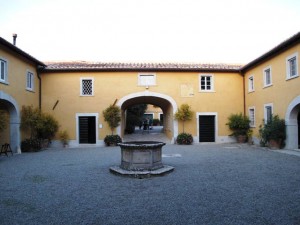
Talk about a "gravel courtyard" - this is the stunning entrance to La Foce's Casa and Tattoria
LA FOCE in the 20th Century
In 1924, Iris Origo, an Anglo-American writer, and her Italian husband Antonio purchased La Foce. They commissioned Cecil Pinset, an English architect, to enlarge the house and farm, restore old farmbuildings and create a garden. The remarkable couple invested their lives in this region, creating lifelong connections with the people who lived on the land. They built a school and dayhospital and used the many restored buildings for housing local farm workers. Origo’s autobiography, Images and Shadows, Part of a Life, documents the half-century development of this magical Tuscan estate.
Today, La Foce is in the hands of Iris and Antonio’s two daughters, who open the grounds on a limited basis for tours. Seattle garden writer and friend Marty Wingate set up the tour for us, but at the very last moment she was unable to come on our trip to Tuscany. We thought of Marty often during our lovely tour and took as many photos as possible to bring home to share.

Antonella Piredda, "guida turistica," our lovely guide
By the time we arrived at La Foce, we had already spent a few hours touring with Antonella Piredda, our personal Siena guide and new friend (Heading to Siena? You can contact her at antonella.piredda@live.it). Enchanted by her engaging Sardinian accent and perfect English, her cleverness and sense of humor as she told us the stories of Tuscany’s history that you can’t find in a guidebook, and our leisurely touring agenda, we were not quite prepared for the brisk pace and tight timeline maintained by the docent who greeted us a La Foce.
That dear woman had no idea what to do with all of us garden fanatics and our cameras. We did not stick to the program, but instead, wandered off to capture photos of the garden and home without people cluttering the frame. One glorious hour here was insufficient.
Whatever you feel about formal, clipped hedges and symmetrical lines, you can certainly gain inspiration from the proportions, scale and use of perspective in this magnificent garden.
Here are the lessons I learned that afternoon.
1. The best gardens reveal the “Double Human Inclination of Formality and Informality.”
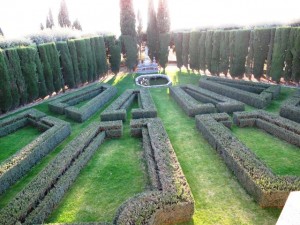
Okay, this is amazing. In 1939, just before the war, the formal lower garden was created with double-box hedges leading to a low, travertine pond.
Ponder this notion. I actualy wrote it down in my little moleskin notebook and then re-read it a few times. Our La Foce guide, Bernadetta, uttered these words as she described parts of the cultivated landscape. Wow – they started to make a lot of sense.
As I tour and study a vast array of gardens — ranging from famous estates to humble city parcels and in between — I can see what she means.
Whenever you have informality, you have to add structure, lines, mass or symmetry of some kind. Otherwise, that informality looks like a wild, disorganized mess. On the other hand, if your intent is to have formality, you need to soften it with natural, looser forms, usually conveyed by planting choices. Otherwise, the garden looks stiff and inhospitable. That balanced tension makes for a more appealing garden. (I could go on and talk about formality and informality in my life, but that’s another blog post!)
2. Green is the ideal garden palette.
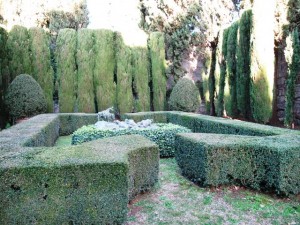
A tiny but powerful all-green vignette stands between the villa and the limonaia.
I know there is the whole trend of colored foliage, the “hot” garden, the “cool” garden, and all sorts of color theories revealed in planting combinations (analogous, complementary, etc.). But take a look at La Foce. The use of green has worked pretty well there for something like 85 years (and probably for centuries before Iris Origo arrived).
It is pleasing to the eye and excellent-looking in all four seasons. Clipped or natural, green is classic and you can’t go wrong with it. Nice to add touches of color here and there, but not essential — to my eye, at least.
3. Perspective, points-of-view, sight-lines make a big difference in one’s garden experience.
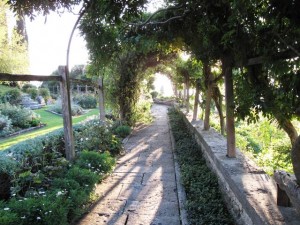
Sunlight streams through the barrelvault pergola and invites you to explore further
I have written ad nauseum about the notion of “framed views” and “focal points” as design concepts. But hey – here at La Foce, these ancient tricks reveal themselves with gusto. It’s all about how design choices intentionally lead the eye around and through the garden. Each path, each level, each angled or curved turn. . . is a device for drawing you through space both visually and physically.
As a result, the experience is more enjoyable. Like a journey that feels much longer and more evocative than the actual distance you’ve covered.
4. Timeless gardens have unspeakable power.
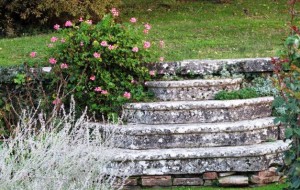
Various shades of lichen have turned stone steps into a lovely tapestry of hues.
I wrote about the idea of a timeless garden in my book, The Abundant Garden. It was my description of the late Anne Holt’s 50-year-old Bainbridge Island property. Every word I wrote in that chapter could be applied to La Foce, but multiplied by even more decades of time. If you have time to wait, your garden will reward you. Thoughtful planning isn’t always my forte (I subscribe to the notion that you can’t have instant horticultural gratification unless you plant a container garden), but the lessons at La Foce remind me what you can reap if you slow down, take time to consider design choices and just wait, watch, and enjoy the process.
Imagine staying and gardening in one place for so long that the trees are taller than the architecture, that the trunk of a wisteria vine is thicker than your wrist, that the stone takes on a gorgeous, not-to-be-rushed patina of moss and lichen?
That’s the vibe at La Foce. Here are several more images to delight your eyes:
A view from La Foce of the zig-zagging, hilly drive, dotted with Italian cypress. It is the most-photographed scene in Tuscany.
Two enormous, dome-shaped Ilex trees stand on both sides of the loggia. The one on the right dates to 1924
The late afternoon, autumn light casts a honey-colored glow over La Foce's terraces
Two pilasters topped by Pinsent vases in travertine mark the entrace to the lemon garden, built in 1933.
The panoramic view of Monte Amiata and the Tuscan valley. Who wouldn't have moved here and stayed for a lifetime?
Discovered in the rose garden: an ornamental stone bench - as grand as the headboard on a princess's bed.
Formality in the foreground, this little scene caught my eye more than once. I took countless photographs of the stone table in the shelter of a wooden arbor. The portal-like opening in the hedges create a room-within-a-room
Ivy-leaf pelargoniums thrive here and practically everywhere in Tuscany.
Pinset designed the Limonaia (orangery) after 18th century models. The potted lemon trees had just been moved inside for the winter, so we had to imagine them in the garden.
La Foce's facade is still as it looked in its "osteria" days, except for the upper loggia, which was closed up in the 19th century. Various coats of arms decorate the facade.
Intentionality. It's all about intentionality. Gardeners have spent years maintaining this clipped opening in a hedge, protecting a nearly-secret garden bench.









November 10th, 2009 at 9:16 am
A veritable tour de force, Debra. Good to have you back . . . rested and full of new insights and energy.
.-= David´s last blog ..Macro in a Mason Jar =-.
November 10th, 2009 at 9:42 am
Ms Plato is doing her happy dance!!! Beautifully wistful.
.-= Lorene´s last blog ..Herbs for pampering =-.
November 10th, 2009 at 1:14 pm
The views are incredible. I am green with envy. I hope that the experience was as good as it looks and sounds. Memorable images with another book in the wings?
November 10th, 2009 at 1:52 pm
Great post – your photos aptly demonstrate the concepts, plus they really make me wish I was in Tuscany right now.
.-= Mr. McGregor’s Daughter´s last blog ..The Joy of Leaf Mold =-.
November 10th, 2009 at 3:16 pm
As one of the people standing next to you at La Foce, I agree, a beautiful, beautiful place. We did not have near enough time to explore it properly. I am still of the mind we should have had a glass of Tuscan red in hand to watch the sun set over the iconic landscape. Ciao BELLA!
.-= Mary Ann´s last blog ..Why I Garden – A contest =-.
November 10th, 2009 at 3:19 pm
I know how tired you must be, so thank you for taking the time to share such an instructive post. I have always felt the “Double Human Inclination of Formality and Informality” but had never been able to articulate it. I will not soon forget it.
.-= Kathy from Cold Climate Gardening´s last blog ..Mini Guest Post =-.
November 10th, 2009 at 4:06 pm
Hi, Deb — Happy half century! What a great place to celebrate, surrounded by timeless beauty and great garden design. That photo you captioned “The panoramic view of Monte Amiata and the Tuscan valley. Who wouldn’t have moved here and stayed for a lifetime?” could be Southern CA. Too bad we don’t have those great Tuscan estates, too! Debra
November 10th, 2009 at 4:47 pm
What a wonderful, insightful post. Thank you for sharing it with us.
November 11th, 2009 at 8:59 am
I relived the experience all over again. Your piece really captures the splendor of the place–and what that grand garden can tell us about organizing our own small plots.
November 11th, 2009 at 12:13 pm
Debra, mille grazie for sharing your memories and impressions, as well as your photographs, of La Foce. I look forward to more posts on your time under the Tuscan sun.
.-= Cindy, MCOK´s last blog ..Through the Garden Gate: Monday, November 9, 2009 =-.
November 11th, 2009 at 6:27 pm
Can’t wait for more of your Italian epiphanies. I couldn’t design landscapes without knowing the secret of alternating formal & informal garden rooms. Yes, learned in Italy. LOL, posted about it today on my blog using Great Dixter pics. Vanishing Threshold was born in Italy.
Congrats on your Martha Stewart interview. With those pics she should do a lifestyle book about skin care, hair, make-up, clothing, & etc. She looks great.
Garden & Be Well, XO Tara
July 6th, 2010 at 2:40 am
Your article was very interesting and informatiative. I learned something new today. And here i want to share something with you,we also have different kinds of porcelain tiles,tiles made of ceramic, porcelain or natural stone which are in good quality and very nature.Welcome to contact us at your convenience.Trust us,we could be helpful.Thank you.